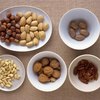Most Americans consume more calories than they need but far fewer than the amount of fiber recommended for healthy adults each day. A 1,200-calorie high-fiber diet can remedy both problems, but one with so few calories should only be attempted by some women. Men, pregnant or nursing women and individuals who are very physically active need a diet that supplies more than 1,200 calories per day. In addition, excessive fiber intake may limit the absorption of certain minerals, interfere with the function of some medications and exacerbate the symptoms of certain medical conditions.
Fiber Recommendations
The minimum amount of fiber you should consume daily is 14 grams for every 1,000 calories, meaning the least amount you should get each day on a 1,200-calorie diet is around 17 grams. Women between 19 and 30 years old are advised to consume 28 grams of fiber a day, while 31- to 50-year-olds should have 25 grams and women 51 and over 22 grams. A high-fiber diet for a woman of any age should supply, on average, at least 25 grams per day.
Sample Breakfast Plans
Writing for Weightlossresources.co.uk, registered dietitian Juliette Kellow suggests a meal of 6 tablespoons of bran flakes topped with three dried apricots, one small banana and nonfat milk as breakfast on a low-calorie, high-fiber diet. Eating this would supply you with approximately 275 calories and almost 7 grams of fiber. Another alternative that supplies a comparable amount of calories and fiber could be egg whites or egg substitute scrambled with 1/2 cup of chopped vegetables and served with an orange and whole-wheat toast spread with 1 teaspoon nut butter.
Sample Lunch Plans
For a lunch with under 400 calories but nearly 8 grams of fiber, have a sandwich made from whole-wheat bread, sliced skinless chicken breast, sliced tomatoes and 2 teaspoons of reduced-calorie mayonnaise, if desired. For dessert, have a piece of whole fresh fruit and nonfat yogurt. To up your fiber intake, leave the skin on fruit whenever possible. Unpeeled fruits like apricots, apples and pears are low in calories but have 3 or more grams of fiber per serving. A 1/2-cup serving of lentil salad and a slice of whole-wheat bread spread with 1/4 cup of homemade hummus could also serve as lunch on the diet. The combo would supply over 9 grams of fiber.
Sample Dinner Plans
Fill up on high-fiber vegetables, limit your intake of fatty animal products and keep your portion sizes under control when you're planning your dinners on a fiber-rich 1,200-calorie diet. One option, which supplies around 465 calories and about 14 grams of fiber, might be a green salad paired with a potato baked with the skin intact and topped with sauteed cooked beans and 2 tablespoons of low-fat cheese. A 3-ounce serving of seafood such as scallops or shrimp served with 1 1/2 cups of steamed or stir-fried fresh vegetables like asparagus, carrots and broccoli and 1/2 cup of brown rice is another good choice. Follow it with a dessert of 1 cup of fresh raspberries for a meal containing over 12 grams of fiber.
Sample Snack Plans
While you're on the diet, it's vital to choose snacks that will increase your fiber intake without supplying you with too many calories. Snacking on chips or sugary baked goods won't help you reach your goal. Instead, have fresh fruit like an apple or strawberries -- a small bowlful has 1 gram of fiber -- when hunger hits in the midmorning or late afternoon. Raw vegetables like carrot sticks can have over 2 grams of fiber in every serving, but it's best to skip the dip to keep your calorie intake low. Raw or toasted nuts contain just under 1 gram of fiber per serving, though eating more than 1 ounce will quickly add to your calorie total.
Additional Considerations
Suddenly increasing the amount of fiber in your diet can cause digestive problems like constipation, bloating, gas and abdominal cramping. To minimize these side effects, drink at least 48 to 64 ounces, or six to eight 8-ounce glasses, of clear fluid daily. A caffeine-free liquid like water is the best choice. You can also lower the risk of digestive side effects by slowly increasing your fiber consumption over a period of several weeks.
References
- Weightlossresources.co.uk: High Fiber Diet Plan Sample Menu
- Brigham and Women's Hospital: 1,200 Calorie Meal Plan
- Cleveland Clinic: Improving Your Health With Fiber
- Centers for Disease Control and Prevention: Carbohydrates
- USDA National Nutrient Database: Hummus, Home Prepared
- USDA National Nutrient Database: Rice, Brown, Long-Grain, Cooked
Writer Bio
Michelle Kerns writes for a variety of print and online publications and specializes in literature and science topics. She has served as a book columnist since 2008 and is a member of the National Book Critics Circle. Kerns studied English literature and neurology at UC Davis.
Image Credit
Medioimages/Photodisc/Photodisc/Getty Images




